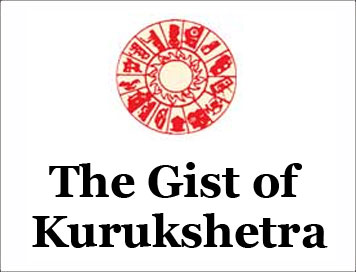(HOT) UPSC Current Affairs 2025 PDF
NEW! The Gist (NOV-2025) | E-BOOKS
(GIST OF KURUKSHETRA) UNORGANISED WORKERS AND SOCIAL SECURITY MEASURES – AN OVERVIEW
(GIST OF KURUKSHETRA) UNORGANISED WORKERS AND SOCIAL SECURITY MEASURES – AN OVERVIEW
(SEPTEMBER-2025)
UNORGANISED WORKERS AND SOCIAL SECURITY MEASURES – AN OVERVIEW
Context:
The evolving unorganised sector is a pivotal characteristic of Indian economy. It is estimated that more than 90 per cent workforce engages in unorganised sector and contributes around 50 per cent to Gross Domestic Product (GDP) of the country. Despite their outstanding contribution to the Indian economy the workers of this sector remain as the marginalised class of the society. It is doubtless to say that majority of them live below poverty line and fail to fulfil their basic requirements. Besides, exploitation, ill-treatment, gender discrimination are some of the vital problems faced by them on day-to-day basis. The Unorganised Worker’s Social Security Act, 2008 is the only act enacted exclusively for the workers of unorganised sector. The act empowered the government to undertake social security measures for the informal sector workers.
Categorisation of Unorganised Workers
As per the Ministry of Labour, workers are divided into four major groups:
Occupational Groups:
-
Engaged in agriculture or traditional trades.
-
Examples: Small, marginal and landless farmers, Agricultural labourers, sharecroppers, Fishermen, Beedi rollers, labelling and packing workers, Animal husbandry workers, Construction workers, leather workers, salt workers, Brick kiln workers, saw-mill and oil-mill workers, Weavers, artisans, stone quarry workers.
Nature of Employment:
-
Workers in insecure and unstable jobs.
-
Examples: Bonded labourers, Migrant workers, Contract workers, Casual labourers.
Especially Distressed Categories
-
Engaged in hazardous, socially stigmatised, or extremely low-income activities.
-
Examples: Toddy tappers, Scavengers, Head-load carriers
-
Drivers of animal-drawn vehicles
-
Coolies engaged in load/unload work.
Service Categories
-
Self-employed or low-wage service providers.
-
Examples: Midwives, domestic workers, Fisherwomen, Barbers, Vegetable and fruit vendors, Newspaper vendors.
Conceptual Understanding (National Commission on Labour, 1969)
The unorganised sector is characterised by:
-
Casual, irregular, and temporary employment.
-
Illiteracy and ignorance, preventing collective bargaining.
-
Marginalised, small-sized establishments with low capital.
-
Geographically scattered nature of work.
-
Weaker workers vs. stronger employers leading to dependency and exploitation.
Major Problems Faced by Unorganised Workers:-
-
Low Wages: No concept of “equal pay for equal work”. No additional benefits like allowances, bonus, incentives, or fringe benefits. Rampant exploitation and discrimination.
-
Lack of Job Security: Work is seasonal, casual, and unstable. No coverage under Provident Fund, Pension, Bonus, Maternity or Factory Acts. Employment depends solely on the will of the employer.
-
Lack of Protection: Exploited by middlemen, contractors, and employers. Work in unsafe and unhygienic conditions. Women face sexual harassment, children face abuse. Trade unions rarely represent them due to scattered presence.
-
Deprivation of Basic Amenities: Poor housing, congested rooms, no sanitation, no potable water. Families live in slum-like conditions. Children deprived of education, healthcare, nutrition.
-
Traditional and Outdated Techniques: Lack of access to modern skills and technology. Labour-intensive methods leads lower productivity. Unable to compete with mechanised industries, leading to job loss.
-
Poverty and Exploitation: Economic compulsion keeps them trapped in informal jobs. Limited ability to mobilise capital or increase productivity. Paid lump-sum wages often fall into indebtedness.
Legislative and Policy Framework
Unorganised Workers’ Social Security Act, 2008
-
First law dedicated to informal workers.
-
Enabled the government to design social security measures.
-
However, its implementation remained weak.
Code on Social Security, 2020
-
Consolidated multiple labour laws into one comprehensive code.
-
Extended coverage to: Organised, unorganised, gig, and platform workers.
-
Introduced wider ambit of social benefits beyond wages.
-
it has been designed to reduce confusion from multiple overlapping laws.
-
Provide health, pension, maternity, and disability benefits.
Government Schemes for Unorganised Workers
Life and Disability Cover
-
Pradhan Mantri Jeevan Jyoti Bima Yojana (PMJJBY)
-
₹2 lakh coverage for death (any reason).
-
Premium: ₹436/year.
Impact of Social Security Expansion:
-
India’s social protection coverage rose from 24.4% (2021) → 48.8% (2024).
-
920 million people are now covered under at least one scheme.
-
24.8 crore people escaped multidimensional poverty in the past decade.
-
Shift towards inclusive, welfare-oriented governance.
Way Forward:
-
Universal Registration – Aadhaar-linked unified database.
-
Portable Benefits – Schemes should move with workers across states/jobs.
-
Simplified Contribution Models – Micropayment systems for irregular incomes.
-
Awareness Campaigns – Information on entitlements at grassroots level.
-
Multi-stakeholder Financing – Shared responsibility of state, employers, workers.
Conclusion:
With a view to implement the above schemes successfully, the Government should take adequate steps in order to sensitise the workers about their rights since most of them are not aware of their rights and remedies in case of breach. We need to remember the words of Prime Minister Shri Narendra Modi, “Even small efiorts to bring about change in the social fabric, eventually reap largefruits.”
CLICK HERE TO DOWNLOAD FULL PDF
CLICK HERE TO DOWNLOAD UPSC E-BOOKS
Study Material for UPSC General Studies Pre Cum Mains
Get The Gist 1 Year Subscription Online
Click Here to Download More Free Sample Material
<<Go Back To Main Page
Courtesy: Kurukshetra



